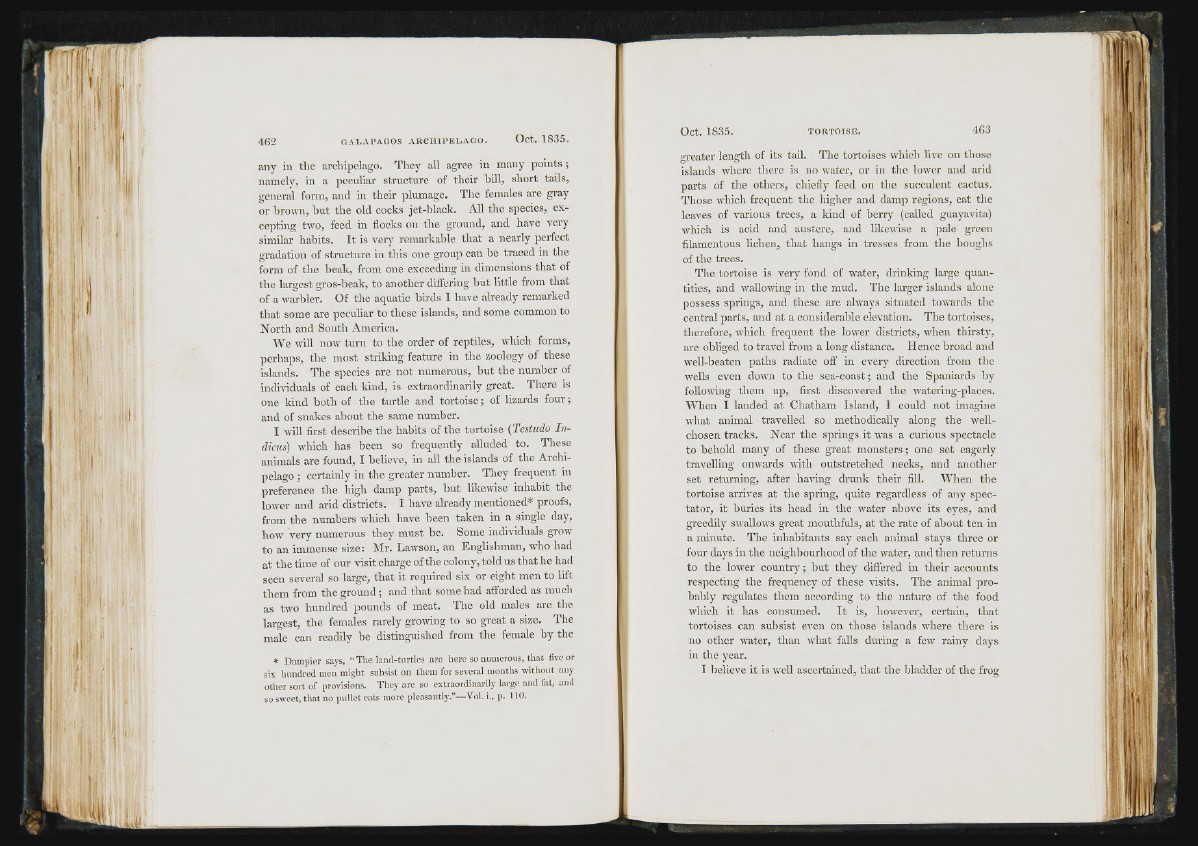
i ' '
any in the archipelago. They all agree in many points ;
namely, in a peculiar structure of their hill, short tails,
general form, and in their plumage. The females are gray
or broivn, but the old cocks jet-black. All the species, excepting
two, feed in flocks on the ground, and have very
similar habits. It is very remarkable that a nearly perfect
gradation of structure in this one group can be traced in the
form of the beak, from one exceeding in dimensions that of
the largest gros-beak, to another differing but little from that
of a warbler. Of the aquatic birds I have already remarked
that some are peculiar to these islands, and some common to
North and South America.
We will now turn to the order of reptiles, which forms,
perhaps, the most striking feature in the zoology of these
islands. The species are not numerous, but the number of
individuals of each kind, is extraordinarily great. There is
one kind both of the turtle and tortoise ; of lizards four ;
and of snakes about the same number.
I will first describe the habits of the tortoise {Testudo Indiens)
which has been so frequently alluded to. These
animals are found, I believe, in all the islands of the Archi-
pelago ; certainly in the greater number. They frequent m
preference the high damp parts, hut likewise inhabit the
lower and arid districts. I have already mentioned* proofs,
from the numbers which have been taken in a single day,
how very numerous they must be. Some individuals grow
to an immense size: Mr. Lawson, an Englishman, who had
at the time of our visit charge of the colony, told us that he had
seen several so large, that it required six or eight men to lift
them from the ground ; and that some had afforded as much
as two hundred pounds of meat. The old males are the
largest, the females rarely groiving to so great a size. The
male can readily be distinguished from the female by the
* D am p ie r says, “ T h e la n d - tm tle s a r e h e re so n um e ro u s , t h a t five o r
s ix h u n d r e d m en m ig h t su b s is t o n th em fo r s e v e ra l m o n th s w itlio u t an y
o th e r s o rt o f p ro v isio n s. T h e y a r e so e x tr a o rd in a rily la rg e a n d fitt, a n d
so sw e e t, th a t n o p u l le t e a ts m o re p le a s a n tly .”— Vol. i., p . 1 10.
greater length of its tail. The tortoises which live on those
islands where there is no water, or in the lower and arid
parts of the others, chiefly feed on the succulent cactus.
Those whioh frequent the higher and damp regions, eat the
leaves of various trees, a kind of berry (called guayavita)
which is acid and austere, and likewise a pale green
filamentous lichen, that hangs in tresses from the boughs
of the trees.
The tortoise is very fond of water, drinking large quantities,
and wallowing in the mud. The larger islands alone
possess springs, and these are always situated towards the
central parts, and at a considerable elevation. The tortoises,
therefore, which frequent the lower districts, when thirsty,
are obliged to travel from a long distance. Hence broad and
well-beaten paths radiate off in every direction from the
wells even down to the sea-coast; and the Spaniards hy
following them up, first discovered the watering-places.
When I landed at Chatham Island, I could not imagine
what animal travelled so methodically along the well-
chosen tracks. Near the springs it was a curious spectacle
to behold many of these great monsters; one set eagerly
travelling onwards with outstretched necks, and another
set returning, after having drunk their fill. When the
tortoise arrives at the spring, quite regardless of any spectator,
it buries its head in the water above its eyes, and
greedily swallows great mouthfuls, at the rate of about ten in
a minute. The inhabitants say each animal stays three or
four days in the neighbourhood of the water, and then returns
to the lower country; but they differed in their accounts
respecting the frequency of these visits. The animal probably
regulates them according to the nature of the food
which it has consumed. It is, however, certain, that
tortoises can subsist even on those islands where tliere is
no other water, than what falls during a few rainy days
iu the year.
I believe it is well ascertained, that the bladder of the frog
I f
Ilf i
111:
IJi